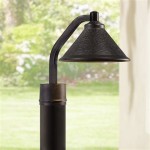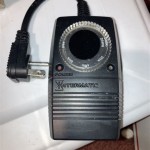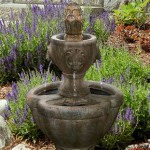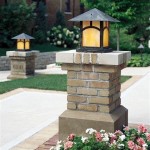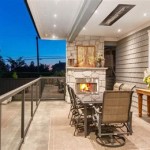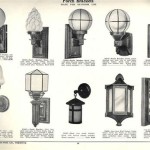Outdoor Lighting Ceiling: Illuminating Your Outdoor Spaces
Outdoor lighting plays a crucial role in enhancing the aesthetics, safety, and functionality of exterior environments. While ground-level and wall-mounted fixtures are common, outdoor ceiling lighting offers a unique and often overlooked solution for illuminating patios, porches, decks, gazebos, and other covered outdoor areas. This article will explore the various aspects of outdoor lighting ceilings, covering types of fixtures, installation considerations, benefits, and factors to consider when choosing the right solution for specific needs.
The term "outdoor lighting ceiling" encompasses a range of fixtures specifically designed and rated for outdoor use that are mounted on the underside of a roof, overhang, or other overhead structural element. These fixtures are intended to provide ambient, task, or accent lighting, depending on the application and the design of the luminaire. Proper selection and installation are paramount to ensure longevity, performance, and, most importantly, safety in the outdoor environment.
Types of Outdoor Ceiling Light Fixtures
A diverse array of outdoor ceiling light fixtures is available, each tailored to different aesthetic preferences and functional requirements. Understanding the characteristics of each type is essential for making informed decisions.
Flush Mount Lights: Flush mount fixtures are designed to sit close to the ceiling surface, making them ideal for areas with low overhead clearance. They provide a general ambient light and are available in various styles, from traditional to contemporary. Due to their minimal protrusion, they are less likely to be damaged by wind or other environmental factors.
Semi-Flush Mount Lights: Semi-flush mount lights offer a compromise between flush mount and pendant fixtures. They hang slightly lower than flush mount options, allowing for a more decorative element while still maintaining a relatively low profile. These fixtures often diffuse light more effectively than flush mounts.
Pendant Lights: Pendant lights are suspended from the ceiling by a chain, rod, or wire. They can be used to create a focal point and provide both ambient and task lighting. Outdoor pendant lights must be specifically rated for outdoor use and should be securely mounted to withstand wind and other weather conditions. The length of the pendant should be carefully considered to ensure sufficient headroom.
Chandeliers: Outdoor chandeliers add a touch of elegance and sophistication to covered outdoor spaces. Similar to pendant lights, they are suspended from the ceiling and provide a decorative and functional lighting solution. Choosing materials that are resistant to corrosion and fading is crucial for outdoor chandelier applications.
Recessed Lighting: Also known as pot lights or can lights, recessed lighting fixtures are installed directly into the ceiling, creating a clean and unobtrusive look. They are effective for providing general ambient lighting or highlighting specific areas. Outdoor recessed lighting requires housings and trims specifically designed for wet or damp locations to prevent water damage.
Track Lighting: Track lighting systems consist of a track mounted to the ceiling with multiple light heads that can be adjusted and positioned to direct light where it is needed. This offers flexibility in lighting design and is particularly useful for illuminating specific features or areas within a covered outdoor space.
Integrated LED Fixtures: Many modern outdoor ceiling lights incorporate integrated LED (Light Emitting Diode) technology. These fixtures offer energy efficiency, long lifespan, and a wide range of color temperatures and light outputs. Integrated LEDs eliminate the need for bulb replacements, reducing maintenance requirements.
Factors to Consider When Choosing Outdoor Ceiling Lighting
Selecting the appropriate outdoor ceiling lighting requires careful consideration of several key factors to ensure optimal performance, safety, and aesthetic appeal. These factors include the intended application, the size of the space, the architectural style, and environmental conditions.
Location and Purpose: The specific location where the lighting will be installed and its intended purpose will significantly influence the choice of fixture. For instance, lighting above a dining table on a covered patio might require brighter, more focused task lighting than general ambient lighting for a porch. For areas exposed to moisture, wet-rated fixtures are essential, while damp-rated fixtures are suitable for covered areas with minimal exposure to the elements.
Size and Scale: The size of the outdoor space should be considered when selecting the size and scale of the lighting fixtures. Overly large fixtures can overwhelm small spaces, while too-small fixtures may not provide adequate illumination for larger areas. The height of the ceiling is also a critical factor. Low ceilings require flush or semi-flush mount options to maximize headroom, while higher ceilings can accommodate pendant lights and chandeliers.
Architectural Style: The style of the lighting fixtures should complement the architectural style of the home and the outdoor space. Traditional homes may benefit from classic designs, while modern homes may be better suited to contemporary or minimalist fixtures. Coordinating the finish and materials of the lighting fixtures with other outdoor elements, such as furniture and landscaping, can create a cohesive and visually appealing aesthetic.
Light Output and Color Temperature: The desired light output, measured in lumens, and the color temperature, measured in Kelvin (K), should be carefully considered. Higher lumen outputs provide brighter light, while lower lumen outputs create a softer, more subdued ambiance. Warmer color temperatures (2700K-3000K) create a cozy and inviting atmosphere, while cooler color temperatures (4000K-5000K) provide a more modern and energetic feel. The layering of light, combining ambient, task, and accent lighting, can create a well-balanced and functional outdoor space.
Durability and Weather Resistance: Outdoor lighting fixtures must be able to withstand the elements, including rain, snow, sun, wind, and temperature fluctuations. Look for fixtures made from durable materials such as stainless steel, aluminum, or weather-resistant plastics. Ensure the fixtures are specifically rated for outdoor use (wet or damp location) and are protected against corrosion, fading, and other forms of deterioration.
Energy Efficiency: Energy-efficient lighting options, such as LED fixtures, can significantly reduce energy consumption and lower electricity bills. LEDs have a longer lifespan than traditional incandescent bulbs, minimizing the need for frequent replacements. Look for fixtures with the Energy Star label to ensure they meet specific energy efficiency standards.
Installation Considerations for Outdoor Ceiling Lights
Proper installation is crucial for the safe and effective operation of outdoor ceiling lights. It is recommended to consult with a qualified electrician to ensure the installation complies with local electrical codes and safety regulations.
Wiring and Electrical Connections: All electrical wiring and connections must be properly grounded and protected against moisture. Use weatherproof connectors and junction boxes to prevent water from entering the electrical system. If running new wiring, ensure it is appropriately sized for the electrical load and is protected by conduit.
Mounting and Support: Securely mount the lighting fixtures to the ceiling structure using appropriate hardware. Consider the weight of the fixture and the potential for wind loads when selecting mounting hardware. For heavier fixtures, reinforcement of the ceiling structure may be necessary.
Weatherproofing: Ensure that all gaps and seams around the fixture are properly sealed to prevent water intrusion. Use weatherproof caulk or sealant to seal any openings and protect against moisture damage. Regularly inspect the fixtures and seals for any signs of wear or deterioration and make repairs as needed.
Ground Fault Circuit Interrupter (GFCI) Protection: Outdoor electrical circuits should be protected by ground fault circuit interrupters (GFCIs) to prevent electrical shock. GFCIs detect imbalances in the electrical current and quickly shut off the power, providing an added layer of safety.
Maintenance: Regular maintenance is essential to ensure the longevity and performance of outdoor ceiling lights. Clean the fixtures regularly to remove dirt, dust, and debris. Inspect the wiring and connections for any signs of damage and make repairs as needed. Replace bulbs promptly when they burn out.
In conclusion, outdoor lighting ceilings offer diverse options for enhancing outdoor living spaces. Selecting appropriate fixtures, considering environmental factors, and adhering to proper installation practices will ensure a safe, functional, and aesthetically pleasing outdoor environment.

Modern Forms Vessel 5 1 2 W Black Led Outdoor Ceiling Light 58y98 Lamps Plus

Lnc Modern 2 Light Matte Black Flush Mount Outdoor Ceiling With Clear Glass Shade For Front Porch Roof Lighting Nvb2eihd1156c78 The Home Depot

Asher Outdoor Flush Mount Black Lighting Ceiling Lights

The Complete Outdoor Light Sizing Guide Design Inspirations Lights Com Blog

Generation Lighting Outdoor Ceiling 1 Light 8 25 In W Black Plastic Square Flush Mount Fixture With Clear Textured Glass Shade 7567 32 The Home Depot

Platter 13 Square Black Led Outdoor Ceiling Light 61x62 Lamps Plus

Outdoor Ceiling Lights Destination Lighting

Outdoor Ceiling Lights Discover Now Eglo

Generation Lighting Barn Light 1 Black Exterior Outdoor Flush Mount Ceiling 7836701 12 The Home Depot

Outdoor Ceiling Lights Entryway Lighting Rejuvenation
